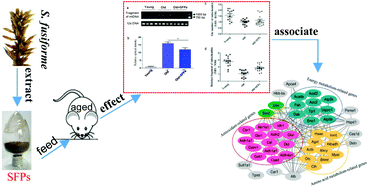Proteomic landscape of liver tissue in old male mice that are long-term treated with polysaccharides from Sargassum fusiforme†
Abstract
Sargassum fusiforme is a type of brown algae and well known as a longevity promoting vegetable in Northeastern Asia. The polysaccharides derived from Sargassum fusiforme (SFPs) have been suggested as an antioxidant component for anti-aging function. However, global molecular changes in vivo by SFPs have not been fully elucidated. Here, we present a proteomics study using liver tissues of aged male mice that were fed with SFPs. Of forty-nine protein spots, thirty-eight were up-regulated and eleven were down-regulated, showing significant changes in abundance by two-dimensional gel electrophoresis. These differentially expressed proteins were mainly involved in oxidation–reduction, amino acid metabolism, and energy metabolism. Forty-six proteins were integrated into a unified network, with catalase (Cat) at the center. Intriguingly, most of the proteins were speculated as mitochondrial-located proteins. Our findings suggested that SFPs modulated antioxidant enzymes to scavenge redundant free radicals, thus preventing oxidative damage. In conclusion, our study provides a proteomic view on how SFPs have beneficial effects on the aspects of antioxidant and energy metabolism during the aging process. This study facilitates the understanding of anti-aging molecular mechanisms in polysaccharides derived from Sargassum fusiforme.



 Please wait while we load your content...
Please wait while we load your content...